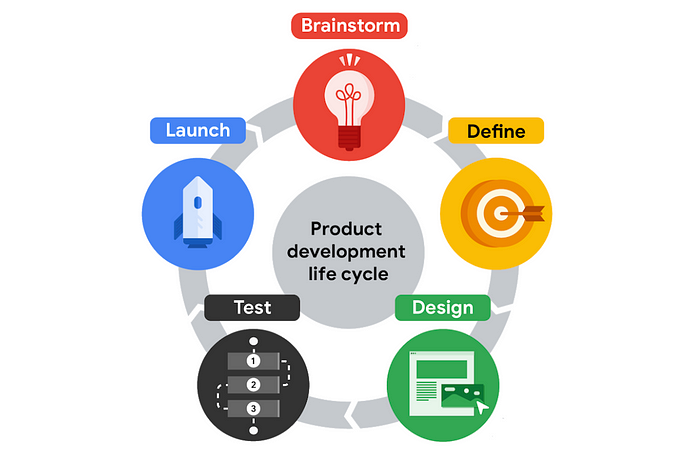The 5 stages of product development life cycle
my understanding of product development life cycle in my own words

What is the product development lifecycle?
The product development life cycle is the process of taking a product from an idea to the market release and beyond. Depending on where you work, the exact names of each stage might be a little different, but the overall process is generally the same.
This cycle involves many departments in a company, designers, developers, QA testers, product managers, and others.
In this article, I am going to briefly define the stages involved in the product development lifecycle.
1. Brainstorm

An active discovery stage that's all about generating ideas about the user and potential needs or challenges that the user might have, it's important to pay attention to the diversity of your team at this stage.
The brainstorming stage is also an ideal time to check out your product's competitors and identify if there are already similar products available in the market, you want your product to fill a gap in the market or solve a problem better than existing products.
note: A UX designer at a large company might not be very involved in the brainstorming stage but a UX designer at a startup or small business could have a big role to play.
2. Define

Using the insights from the brainstorming stage and starting to narrow down the focus. This stage brings UX designers, UX researchers, program managers, and product lead to define the product.
The goal is to figure out the specifications for the product by answering questions like who is the product for? what will the products do? and what features need to be included for the product to be successful?
One product cant solve every user's problem for example an app to help working parents and guardians, your idea should focus on helping parents and guardians find reliable childcare or manage their schedule, not both. In this stage, the UX designer might help the team pin down the focus of the idea, but a product lead will probably be the one to define the scope of the project.
3. Design

Here the implementation of insights into new designs using various tools is done. At this stage UX designers develop the ideas for the product, generally, UX designers start by drawing wireframes, which are outlines or sketches of the product, then move on to creating prototypes, which are early models of a product that convey its functionality.
UX writers are also involved in the design stage and might do things like write button labels. At this point in the lifecycle, UX designers make sure to include all of the product specifications that were outlined in the define stage and ensure each part of the design fits together.
UX designers also make sure that each task a user needs to complete is clear and easy to understand, like navigating from the homepage to the checkout confirmation page in an app.
4. Test

Evaluating the product designs based on the feedback of the potential users.
UX designers work with engineers to develop functional prototypes that match the original designs, including details and features that fit the company's brand, like font and color choices. This also means writing the code and finalizing the overall structure of the product.
At this stage, the designs go through at least 3 phases of testing internal tests: within the company reviews with stakeholders, and external tests with potential users.
First, the team tests the product internally to look for technical glitches and usability problems. This is often referred to as alpha testing
Then the product undergoes tests with stakeholders to make sure the product is aligned with the companies vision, meets legal guidelines for accessibility. and follows government regulations for privacy, for example.
Finally, there's an external test with potential users. This is the time to figure out whether the product provides a good user experience, meaning its usable, equitable, enjoyable, and useful. This is often referred to as beta testing.
Gathering and implementing feedback at this stage is absolutely critical. If users are frustrated or confused by your product, UX designers make adjustments or even create a new version of the design then the designs are tested again until little or no friction between the product and the user.
5. Launch

Sharing a finished version of the product with the public.
Marketing professionals on your team might post about the new product on social media or publish a press release. The customer support team might get ready to help new users learn how the product works.
Program managers also meet with cross-functional teams to reflect on the entire product development life-cycle and ask questions like what worked and what could be improved? were goals achieved? were timelines met? making time for this reflection is super important since it can help improve the process going forward.
For a physical product, the launch stage might be the end of the product development life cycle. But for a digital product, like an app or website, launching the product to a wider audience provides another opportunity to improve on the UX. So, after the launch stage, teams will often cycle back to the design stage and testing stages to start working on the next version of the digital products.

